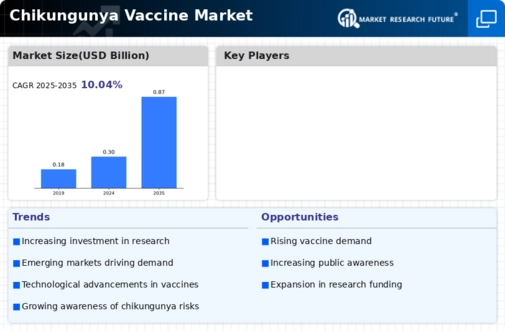Market Trends
Key Emerging Trends in the Chikungunya Vaccine Market
The chikungunya vaccine market is witnessing notable trends that reflect the evolving landscape of healthcare, infectious disease prevention, and global efforts to combat mosquito-borne infections. These trends are shaping the trajectory of the chikungunya vaccine market and influencing stakeholders, including researchers, pharmaceutical companies, and healthcare providers.
Increasing Global Awareness: Awareness regarding mosquito-borne diseases, including chikungunya, has been on the rise globally. The increasing dissemination of information through various channels, including social media, healthcare campaigns, and educational programs, has contributed to a greater understanding of the risks associated with these infections. This heightened awareness is driving individuals to seek preventive measures, including vaccination.
Advancements in Vaccine Development: The field of vaccine development is experiencing significant advancements, driven by scientific breakthroughs, technological innovations, and collaborative research efforts. Researchers are exploring novel approaches, including recombinant viral vaccines and chimeric-alphavirus candidates, to enhance the efficacy and safety of chikungunya vaccines. These developments are contributing to a more robust pipeline of vaccine candidates with the potential for increased effectiveness.
Government Initiatives and Support: Governments worldwide are recognizing the public health impact of mosquito-borne infections and are actively supporting initiatives for vaccine development and distribution. Increased government funding, regulatory support, and partnerships with pharmaceutical companies are creating a conducive environment for accelerated research and the introduction of effective chikungunya vaccines to the market.
Rising Unmet Needs in Developing Countries: While progress is being made in vaccine development, there remains a substantial unmet need for chikungunya treatment in developing and underdeveloped countries. The prevalence of chikungunya in these regions, coupled with limited access to healthcare resources, underscores the importance of affordable and accessible vaccines. Stakeholders are recognizing this gap and working towards solutions that address the specific challenges faced by these populations.
Global Collaborations and Partnerships: Collaborations between research institutions, pharmaceutical companies, and international health organizations are becoming increasingly prevalent. These partnerships facilitate the pooling of resources, expertise, and data to expedite vaccine development processes. The global nature of the chikungunya threat necessitates collaborative efforts to ensure that vaccines are effective across diverse populations.
Technological Integration in Vaccine Distribution: The distribution of vaccines is a critical aspect of infectious disease prevention. Technological advancements, including cold chain management, temperature monitoring, and supply chain innovations, are being integrated into vaccine distribution processes. This ensures the integrity of vaccines during transportation and storage, especially in regions with challenging logistical conditions.
Focus on Vector Control: In addition to vaccination, there is a growing emphasis on vector control strategies to manage mosquito populations and reduce the transmission of chikungunya. Integrated approaches that combine vaccines with vector control measures, such as mosquito nets, insecticides, and community-based interventions, are gaining traction as part of comprehensive public health programs.
Epidemiological Surveillance and Data Analytics: The use of epidemiological surveillance and data analytics is enhancing our understanding of the dynamics of chikungunya outbreaks. Real-time data collection, analysis, and modeling contribute to more effective response strategies, including targeted vaccination campaigns in high-risk areas. This data-driven approach is optimizing resource allocation and improving overall outbreak management.
The chikungunya vaccine market is undergoing dynamic changes influenced by global awareness, scientific advancements, collaborative initiatives, and a holistic approach to infectious disease control. These trends signify a collective effort to address the challenges posed by chikungunya and underscore the importance of innovative solutions in the ongoing battle against mosquito-borne infections.




Leave a Comment